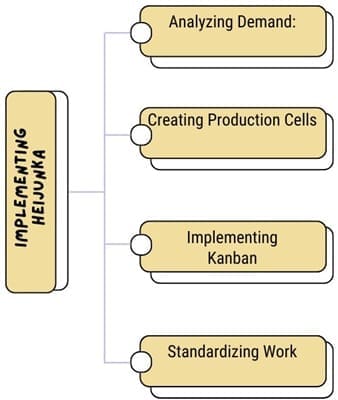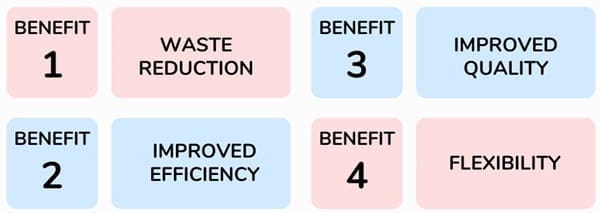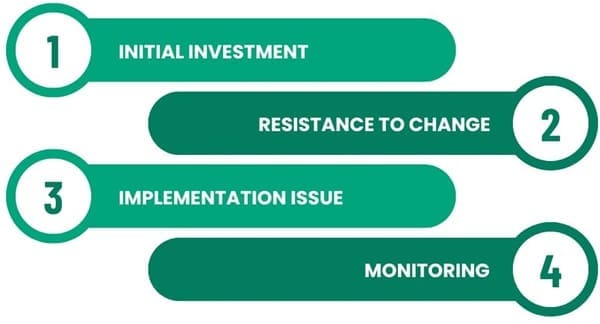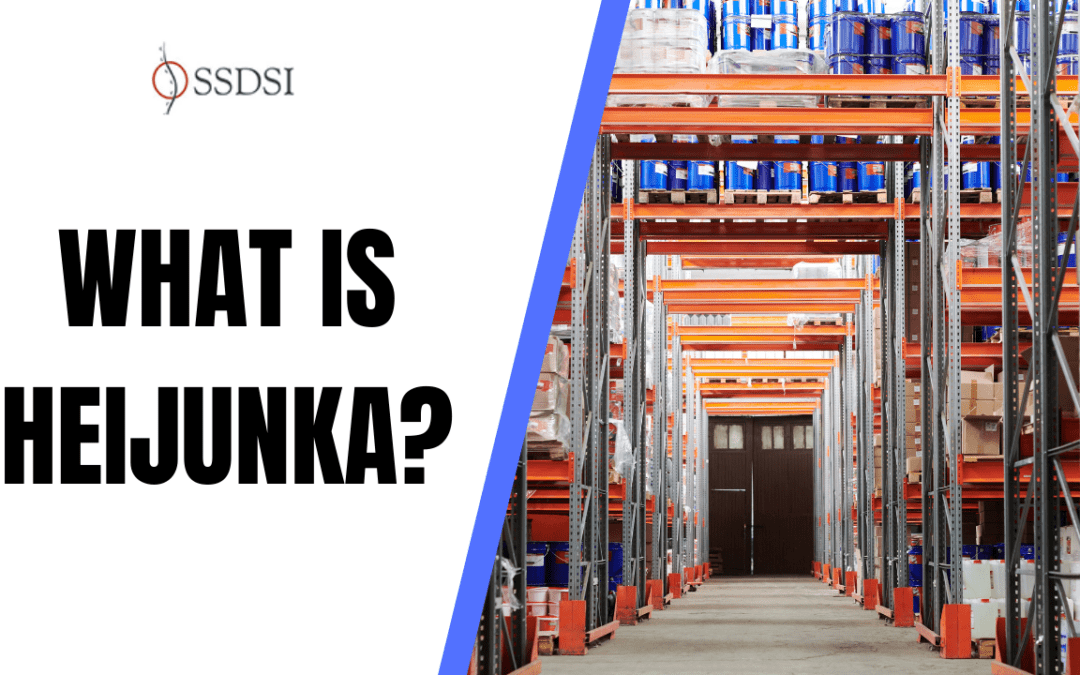Heijunka is one of thirteen pillars in the Toyota Production System. It was created to reduce unevenness and save costs. This is a Japanese word for “levelling” or “production smoothing”. It allows companies to optimize their inventory system to meet the needs of customers and to depend on customer purchasing rates. This is a lean production method.
It reduces overproduction through processing orders according to customer demand, and avoiding batch production. This method is used to maintain consistency in production and balance the output.
The goal of this process is to improve the flow and better match the customer’s demand.
Table of contents
What is Heijunka?
Heijunka levels the production type and quantity over a set period of time. It allows production to meet customer demand efficiently while avoiding batching. This results in minimal inventories, capital cost, manpower and production lead-time throughout the entire value stream. The word Heijunka in Japanese means “levelization.”
The demand for manufacturing products can fluctuate leading to unbalanced production schedules. It can lead to problems such as overproduction, excess inventory or underutilization. Heijunka intends to solve these problems by adjusting production levels to better meet customer demand.
The Toyota Production System depends on the Heijunka. It is a Lean technique for reducing unevenness and minimising the risk of overburdening in production processes. You can use it to react to changes in demand and maximize your capacity.
Heijunka is a simple tool that helps businesses spread out their workload evenly. It aims to avoid chaos caused by uneven production. It includes the concepts of standard work and Kaizen.
The technique uses smaller batches, standard work and/or a single-minute change of die to meet customer demands. Hence, it allows you to stop working in batches and begin processing orders based on customer demand. You can reduce inventory costs by reducing the amount of goods you have in reserve.
With heijunka, your team and your process will protect themselves when the demand increases, as you’ll be producing according to your takt-time, or, simply put, your average selling rate.
Public, Onsite, Virtual, and Online Six Sigma Certification Training!
- We are accredited by the IASSC.
- Live Public Training at 52 Sites.
- Live Virtual Training.
- Onsite Training (at your organization).
- Interactive Online (self-paced) training,
Example of Heijunka
Toyota is the most prominent example of a business that uses Heijunka. Toyota, the Japanese automaker, has abandoned its traditional method of working with batches to schedule car assembly on a production line according to demand.
Also Read: Design for Manufacturing and Assembly (DFMA): Streamline Production
Leveling Method
Heijunka is a method that allows you to deliver value at a constant pace to your customers so you can respond to fluctuations based on your average demand. The method can be used to level production in two different ways:
- Levelling of the volume
- Levelling of types
Levelling of Volume
You need to eliminate batch processing to ensure that you only produce what is ordered. This will keep your inventory costs down.
Lean, in its purest form, teaches you to only start new work when an order comes. This may not be the best option for companies that receive a constant stream of orders, and must adapt their workflow in order to meet demand.
Heijunka lets you level your production based on the average number of orders that you receive.
If, for example, your demand fluctuates daily (Mon 30, Tue 100, Wed 50, etc.), it would be wise to implement Heijunka to level the production by volume. It would be wise to use Heijunka to balance production based on volume.
You can then establish a steady flow of work by processing 50 orders per week to meet the demand.
You can keep your business running smoothly without any extra stress when orders increase during the week.
Levelling of Type
Heijunka can be used to manage a product portfolio. You can organize your work according to the average demand for each product.
You create enough goods to satisfy the average demand of the product portfolio.
If you receive 10 orders per product per week, but only 2 orders per Product B, then you will need to increase your production capacity so that you can produce 20 products each week.
In this case, however, you will need to use Heijunka in order to further level the production so that you can meet demand for every product.
Toyota, to meet this challenge developed an interactive tool called Heijunka box. It helps visualize how many vehicles are needed for each model.
Also Read: Batch Production
Why is it important to level production?
Lean focuses on reducing waste and improving value for the customer. Mura, one of the waste forms (muda), comes from the Japanese for unevenness.
In software development, there is a phenomenon – the death march. After a slow and relaxed start to a project, the majority of work is packed into the final stages. Team members are expected to just do overtime. This kind of almost planned unevenness is not sustainable for the team or the business.
Heijunka is a technique that deals with uneven production levels.
Uneven production can be caused by several factors:
- The time required to perform different activities varies.
- Different products require different time and activities to complete.
- The working and set-up times of different machines and people are different.
- Some items are delayed because people tend to put off the work they dislike.
- Customers don’t usually order in a logical, ordered fashion
- Temporary material shortages may force a deviation from the production schedule.
Heijunka Principles
Heijunka is based on a handful of key principles.
- Flexibility: This allows companies to quickly adjust production schedules in response to changes in customer demand.
- Stability: Heijunka’s levelling of production creates a stable workflow that reduces the stress on equipment and workers.
Application of Heijunka
Imagine a factory that makes both soft toys and tractors. Heijunka could prevent them from making too many soft toys one day, and too many tractors the next depending on the demand. This can cause problems such as overstocked warehouses and rushed production.
Heijunka would allow the factory to level its production, by producing a constant number of soft toys and tractors each day, regardless if there was immediate demand. The factory could use a production system that balances both products equally over time.
Implementing Heijunka
To implement Heijunka requires a few important steps:

- Analyzing Demand: Businesses must study the patterns of demand to determine how much product they should produce.
- Creating Production Cells: Heijunka involves creating production cells. Each cell or unit is responsible for a certain range of products. This allows for more efficient and focused manufacturing.
- Implementing Kanban: Kanban is a visual system that can be used with Heijunka to indicate when and how many products are needed.
- Standardizing Work: Standardizing processes of work helps to ensure consistency and high quality in production lines.
Also Read: Visual Management: Definitions, Tools & Examples for Efficiency
Benefits of Heijunka

- Waste Reduction: Heijunka reduces waste by producing only the amount needed at the time it is needed.
- Improved Efficiency: A smoother production level can result in a more efficient use manpower and resources.
- Improved Quality: Stable workflows and standard processes can lead to higher-quality products.
- Flexibility: Heijunka provides businesses with greater flexibility to adapt to changing market conditions or customer demands.
How do I achieve a Heijunka Flow?
Heijunka requires a company’s commitment to its Lean journey. Lean implementations typically associate leveled production, which often occurs in conjunction with the following practices.
- One minute exchange of die
- Small batch sizes
- Kanban production system driven by customer-facing team and aligned to customer demand
- Know your customer
A company can achieve Heijunka by following these steps:

Step 1: Standardize Work
Standardizing work is the first step in determining how to improve your business. The process will help teams to distinguish between internal and outside work, to learn how to use the assigned operating procedures and to handle errors properly.
Step 2: Improve the takt times
A Lean business executes its work by the takt times of customers and must know when its products are needed. The production team should use Kanban not only to manage the work but also the materials needed according to customer orders.
Toyota’s production department has to submit to the purchasing department, which controls the materials based on the customer demand. Matching your production to the takt time, which is the rate at which customers buy products, will reduce waste.
Step 3: Sequencing
The performance of work takes place in small batches rather than one large batch. Further, delivery of order takes place in the sequence of their placement. Toyota aligns its production and ordering of materials to the Just-in-Time (JIT) method, delivering items only when customers need them.
Standardizing work includes optimizing the system’s capability to quickly change tools and refocus. This allows for efficient sequencing. The company in our example above can only organize their work if they are able to switch from manufacturing triangles and squares to circles without a lot of extra effort. It’s important to minimize set-up time.
Also See: Lean Six Sigma for Hospitals
Challenges of Heijunka

- Initial Investment: Heijunka implementation may require significant initial investment in equipment, education, and process reorganization.
- Resistance to Change: Workers can resist any changes made to production methods or schedules.
- Implementation issue: Heijunka is a complex system to implement, particularly in industries where there are high levels of product variability and demand uncertainty.
- Monitoring: Heijunka requires continuous monitoring and adjustment to remain effective.
Final Words
Heijunka can be a useful tool for manufacturers who want to increase efficiency, reduce waste and align production better with customer demands.
Heijunka allows businesses to operate more effectively and efficiently in today’s dynamic market by creating a stable workflow and smoothing production levels.
Although heijunka can be challenging to implement, its benefits make it worth the effort for companies committed to excellence and continuous improvement.

About Six Sigma Development Solutions, Inc.
Six Sigma Development Solutions, Inc. offers onsite, public, and virtual Lean Six Sigma certification training. We are an Accredited Training Organization by the IASSC (International Association of Six Sigma Certification). We offer Lean Six Sigma Green Belt, Black Belt, and Yellow Belt, as well as LEAN certifications.
Book a Call and Let us know how we can help meet your training needs.




















